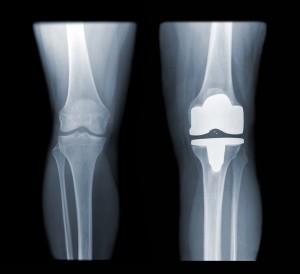

Once the condition and pain worsens knee joint replacement surgery is a treatment option.
Osteoarthritis of the knee is a common condition and typically presents with painful and restricted function and sometimes varus (bow legs) and valgus (knock knees) deformity of the knee. Once the condition and pain worsens knee joint replacement surgery is a treatment option. Patients typically improve in terms of pain and function but there is a recovery period following surgery that can take up to six months.
Cryotherapy (cold therapy) involves the application of very low temperatures to the skin surrounding an injury or surgical site. This is applied either by bags of ice or specialised devices that deliver cooled water to the area.
A new Cochrane review published today, by authors from Australia with the Cochrane Musculoskeletal Review Group, examined the potential benefits of cryotherapy on blood loss, postoperative pain, and range of motion following knee replacement surgery.
Here’s what they did
After searching electronic databases the authors included eleven randomised trials and one controlled clinical trial involving 809 adults who had undergone elective primary (first time) total knee replacement (TKR). Cryotherapy was applied within 48 hours of surgery. They assessed risk of bias of each trial.
Here’s what they found
- Visual analogue score pain at 48 hours: There was very low quality evidence (four trials, 322 participants) that cryotherapy improved VAS (MD = -1.32 points on a 10 point scale, 95% CI, -2.37 to -0.27), but not at 24 or 72 hours. This benefit may not be clinically significant.
- Blood loss: There is very low quality evidence (10 trials, 666 participants) that cryotherapy has a small benefit (SMD -0.46, 95% CI, -0.84 to -0.08), equivalent to 225mL less in cryotherapy group (95% CI, 39 to 410mL). This benefit may not be clinically significant.
- Transfusion rate: There was no difference between groups (RR 2.13, 95% CI 0.04 to 109.63),
- Adverse events: There was no difference between groups (RR = 0.98, 95% CI, 0.28 to 3.47).
- Range of motion at discharge: There is low quality evidence from two trials (107 participants) for improvement (MD11.39 degrees of additional flexion, 95% CI 4.13 to 18.66), but this benefit may not be clinically significant.
- Analgesia use, swelling or length of stay: No significant benefit.
- Knee function: Not measured in any trial.
- Quality of life or activity level: Not reported.
The authors conclusions
“Potential benefits of cryotherapy on blood loss, postoperative pain, and range of motion may be too small to justify its use, and the quality of the evidence was very low or low for all main outcomes.”
The Musculoskeletal Elf’s view
 This review reported only low quality evidence for outcomes of interest. Blinding of participants, clinicians and researchers is a critical component of risk of bias. However studies of this nature are difficult to blind as it is clear to all parties which individuals received the intervention. However some studies included in this review attempted to address this by using cool water.
This review reported only low quality evidence for outcomes of interest. Blinding of participants, clinicians and researchers is a critical component of risk of bias. However studies of this nature are difficult to blind as it is clear to all parties which individuals received the intervention. However some studies included in this review attempted to address this by using cool water.
Interestingly knee function, activity level and quality of life was not reported in any of the included studies. Surely these are key issues for patients! The author’s also recommended that standardised outcome measurements are used in future studies. See our earlier blog highlighting the COMET initiative. and functional outcomes
Do you record pain, knee function, activity levels and quality of life? Which outcome measures do you use? When in the patient’s journey do you measure these?
Send us your views on this blog and become part of the Musculoskeletal Elf community.
Links
- Adie S, Kwan A, Naylor JM, Harris IA, Mittal R. Cryotherapy following total knee replacement. Cochrane Database of Systematic Reviews 2012, Issue 9. Art. No.: CD007911. DOI: 10.1002/14651858.CD007911.pub2
- COMETInitiative http://www.comet-initiative.org/ [accessed 30th August 2012]
- The Musculoskeletal Elf. 2012 Systematic review of patient-specific instruments measuring physical function [accessed 30th August 2012]
- The Musculoskeletal Elf. 2012 Low back pain longer than 6 weeks? Try physiotherapy functional restoration rather than advice [accessed 30th August 2012]
- Cochrane Musculoskeletal Review Group [accessed 30th August 2012]
